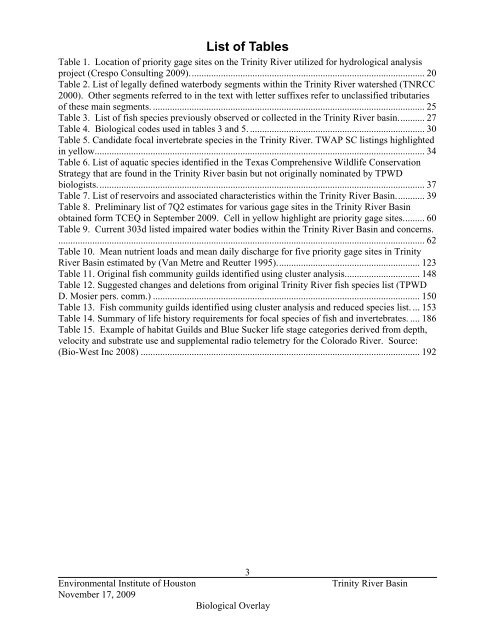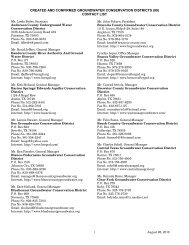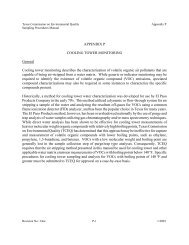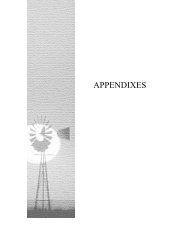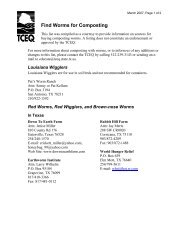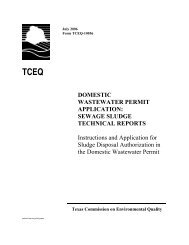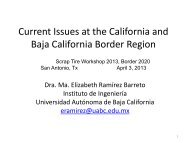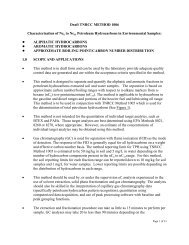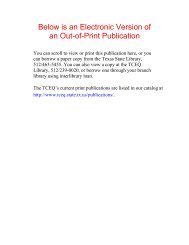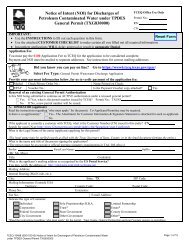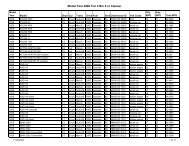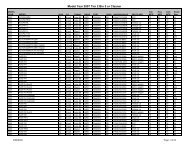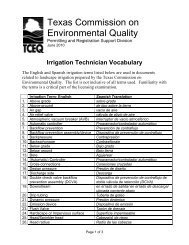Ecological Overlay for the Trinity River for support of Development of ...
Ecological Overlay for the Trinity River for support of Development of ...
Ecological Overlay for the Trinity River for support of Development of ...
You also want an ePaper? Increase the reach of your titles
YUMPU automatically turns print PDFs into web optimized ePapers that Google loves.
List <strong>of</strong> Tables<br />
Table 1. Location <strong>of</strong> priority gage sites on <strong>the</strong> <strong>Trinity</strong> <strong>River</strong> utilized <strong>for</strong> hydrological analysis<br />
project (Crespo Consulting 2009)................................................................................................. 20<br />
Table 2. List <strong>of</strong> legally defined waterbody segments within <strong>the</strong> <strong>Trinity</strong> <strong>River</strong> watershed (TNRCC<br />
2000). O<strong>the</strong>r segments referred to in <strong>the</strong> text with letter suffixes refer to unclassified tributaries<br />
<strong>of</strong> <strong>the</strong>se main segments. ................................................................................................................ 25<br />
Table 3. List <strong>of</strong> fish species previously observed or collected in <strong>the</strong> <strong>Trinity</strong> <strong>River</strong> basin........... 27<br />
Table 4. Biological codes used in tables 3 and 5. ........................................................................ 30<br />
Table 5. Candidate focal invertebrate species in <strong>the</strong> <strong>Trinity</strong> <strong>River</strong>. TWAP SC listings highlighted<br />
in yellow........................................................................................................................................ 34<br />
Table 6. List <strong>of</strong> aquatic species identified in <strong>the</strong> Texas Comprehensive Wildlife Conservation<br />
Strategy that are found in <strong>the</strong> <strong>Trinity</strong> <strong>River</strong> basin but not originally nominated by TPWD<br />
biologists....................................................................................................................................... 37<br />
Table 7. List <strong>of</strong> reservoirs and associated characteristics within <strong>the</strong> <strong>Trinity</strong> <strong>River</strong> Basin............ 39<br />
Table 8. Preliminary list <strong>of</strong> 7Q2 estimates <strong>for</strong> various gage sites in <strong>the</strong> <strong>Trinity</strong> <strong>River</strong> Basin<br />
obtained <strong>for</strong>m TCEQ in September 2009. Cell in yellow highlight are priority gage sites......... 60<br />
Table 9. Current 303d listed impaired water bodies within <strong>the</strong> <strong>Trinity</strong> <strong>River</strong> Basin and concerns.<br />
....................................................................................................................................................... 62<br />
Table 10. Mean nutrient loads and mean daily discharge <strong>for</strong> five priority gage sites in <strong>Trinity</strong><br />
<strong>River</strong> Basin estimated by (Van Metre and Reutter 1995)........................................................... 123<br />
Table 11. Original fish community guilds identified using cluster analysis............................... 148<br />
Table 12. Suggested changes and deletions from original <strong>Trinity</strong> <strong>River</strong> fish species list (TPWD<br />
D. Mosier pers. comm.) .............................................................................................................. 150<br />
Table 13. Fish community guilds identified using cluster analysis and reduced species list. ... 153<br />
Table 14. Summary <strong>of</strong> life history requirements <strong>for</strong> focal species <strong>of</strong> fish and invertebrates. .... 186<br />
Table 15. Example <strong>of</strong> habitat Guilds and Blue Sucker life stage categories derived from depth,<br />
velocity and substrate use and supplemental radio telemetry <strong>for</strong> <strong>the</strong> Colorado <strong>River</strong>. Source:<br />
(Bio-West Inc 2008) ................................................................................................................... 192<br />
3<br />
Environmental Institute <strong>of</strong> Houston<br />
November 17, 2009<br />
<strong>Trinity</strong> <strong>River</strong> Basin<br />
Biological <strong>Overlay</strong>


